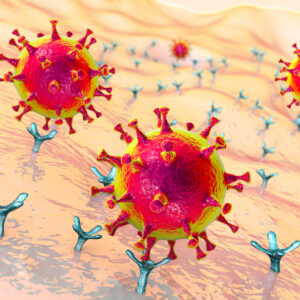Arenavirus Receptors
The Native Antigen Company manufacturers highly purified virus-host cell receptors using state-of-the-art expression and purification techniques. On request we can also undertake custom preparation of recombinant and native proteins for a broad range of disease states.
Arenavirus Receptors Background
The Arenaviridae are a family of viruses whose members are generally associated with rodent-transmitted diseases in humans. The family is divided into three genera based on their natural hosts; Mammarenaviridae, (mammals), Reptarenaviridae (reptiles), and Hartmaniviridae (fish). Mammarenaviridae are further classified into the regions of their origins, including the Old World (OW) viruses found in West Africa and the New World (NW) viruses found in South America.
Arenaviruses are negative-sense, single-stranded RNA viruses belonging to the family Arenaviridae. The virus particles (average diameter 110-130 nm) are enveloped, ambisense single-stranded RNA viruses with a membrane envelope containing the surface glycoprotein (GP) subunits surrounding a capsid, which consists of the Z matrix protein. Inside the capsid are the L RNA-dependent RNA polymerase and the viral bi-segmented genome encapsulated by the nucleoprotein (NP). Cell entry is mediated by GP, which is first expressed as the glycoprotein precursor complex (GPC). A host protease cleaves GPC into its three final subunits: GP1, GP2, and SSP (Stable Signal Peptide), which form heterotrimers on the cell membrane surface. GP1 forms spikes protruding from the viral envelope and is responsible for interacting with entry receptors, while GP2 is a class 1 fusion transmembrane protein with a 6-helix domain.
Many arenaviruses are zoonotic pathogens and are generally associated with rodent-transmitted disease in humans. Each virus usually is associated with a particular rodent host species in which it is maintained. Human infection with an arenavirus is incidental to the natural cycle of the viruses and occurs when an individual comes into contact with the excretions or materials contaminated with the excretions of an infected rodent. The virus enters by inhalation of air-borne viral particles or by eating and/or drinking virus contaminated food or water, respectively. These diseases pose a significant threat to public health, both in the regions where they are occurring and non-endemic areas they are imported into by infected travellers. For example, when the Old World Lassa virus turns into Lassa fever, this usually results in significant mortality. Similarly, the New World Junin virus causes Argentine hemorrhagic fever with a case fatality of 15-30%. There is increasing concern about the potential for arenaviruses to spread across regions and initiate worldwide pandemics.
There are currently very few treatment methods available and the only clinically successful anti-arenaviral vaccine is the Argentinian anti-JUNV Candid #1 strain. The majority of arenaviral drug discovery has focused on small molecule inhibitors of the mammarenaviral glycoprotein and cell entry, using amphipathic DNA polymers to block the interaction between LCMV GP and α-dystroglycan. Clotrimazole derivatives have also been shown to inhibit arenaviral membrane fusion. However, much more research is required on arenavirus receptors for the future development of effective vaccine and therapeutic interventions against mammarenaviruses.
References
- Brisse and Hinh (2019). Hemorrhagic Fever-Causing Arenaviruses: Lethal Pathogens and Potent Immune Suppressors. Front Immunol. 10: 372.
- Arenaviridae (2013). Centers for Disease Control and Prevention.
Arenavirus Receptors
We offer a highly purified arenavirus receptor manufactured using our state-of-the art expression and purification methods.
Questions?
Check out our FAQ section for answers to the most frequently asked questions about our website and company.


